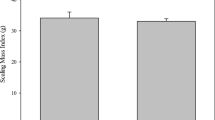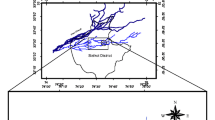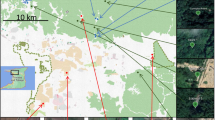Abstract
Amphibians, particularly frogs, are increasingly used as bioindicators of contaminant accumulation in pollution studies. Their use for field scientific purposes is limited because most frog species are endangered and protected in most countries; killing of specimens are not allowed. The aim of our study was to work out and assess a method by which the elemental contents of frog bones could be estimated effectively based on the toe bones. For this purpose, Rana esculenta L. individuals were collected from an urban pond in Debrecen city (Hungary). The following large bones were also analysed: skull, spinal, femur, tibia–fibula, tarsal bones, metatarsus, humerus and digits from front and hind limbs. In the bones, P, Ca, Mg, Mn, Na, S and Zn elements were measured. The elemental contents of large bones were significantly correlated with bones weight in the case of each element. The elemental contents of phalanges were also estimated based on the large bones. The measured and the estimated elemental contents of phalanges were not different significantly based on the tibia–fibula, metatarsalis bones, front and hind limb digits. Elemental analysis based on phalanges adds a further way of use of phalanges. Frogs using their phalanges could be useful indicators in the assessment of environmental contamination.
Similar content being viewed by others
References
Alexander, G. V., Nusbaum, R. E., & MacDonald, N. S. (1955). The relative retention of strontium and calcium in bone tissue. Journal of Biological Chemistry, 218, 911–919.
Beebee, T. C. J., & Griffiths, R. A. (2005). The amphibian decline crisis: A watershed for conservation biology? Biological Conservation, 125, 271–285.
Blaustein, A. R., & Johnson, P. T. J. (2003). The complexity of deformed of amphibians. Frontiers in Ecology and the Environment, 1, 87–94.
Blaustein, A. R., Romansic, J. M., Kiesecker, J. M., & Hatch, A. C. (2003). Ultraviolet radiation, toxic chemicals, and amphibian population declines. Diversity and Distribution, 9, 123–140.
Boyle, D. G., Boyle, D. B., Olsen, V., Morgan, J. A. T., & Hyatt, A. D. (2004). Rapid quantitative detection of chytridiomycosis (Batrachochytrium dendrobatidis) in amphibian samples using real-time Taqman PCR assay. Diseases of Aquatic Organism, 60, 141–148.
Bruce, R. C., Castanet, J., & Francillon-Vieillot, H. (2002). Skeletochronological analysis of variation in age structure, body size, and life history in three species of Desmognathine salamanders. Herpetologica, 58, 181–193.
Castanet, J., & Smirina, E. (1990). Introduction to the skeletochronological method in amphibians and reptiles. Annales des Sciences Naturelles, Zoologie, 11, 191–196.
Elinder, C. G., Friberg, L., Kjellström, T., Nordberg, G., & Oberdoerster, G. (1994). Biological monitoring of metals. Chemical safety monographs. Geneva: World Health Organization.
Flyaks, N. L., & Borkin, L. J. (2004). Morphological abnormalities and heavy metal concentrations in anurans of contaminated areas, Eastern Ukraine. Applied Herpetology, 1, 229–264.
Hartel, T., & Nemes, Sz. (2006). Assessing the effect of toe clipping on Yellow Bellied Toads. Acta Zoologica Academiae Scientiarum Hungaricae, 52, 359–366.
Herkovits, J., & Helguero, L. A. (1998). Copper toxicity and copper–zinc interactions in amphibian embryos. Science of the Total Environment, 221, 1–10.
Icochea, J., Quispitupac, E., Portilla, A., & Ponce, E. (2002). Framework for assessment and monitoring of amphibians and reptiles in the lower Urubamba Region, Peru. Environmental Monitoring and Assessment, 76, 55–67.
Janus, A. M., Faryna, M., Haberko, K., Rakowska, A., & Panz, T. (2008). Chemical and microstructural characterization of natural hydroxyapatite derived from pig bones. Microchimica Acta, 161, 349–353.
Klepinger, L. L. (1984). Nutritional assessment from bone. Annual Review of Anthropology, 13, 75–96.
Loumbourdis, N. S., Kostaropoulos, I., Theodoropoulou, B., & Kalmanti, D. (2007). Heavy metal accumulation and methallothionein concentration in the frog Rana ridibunda after exposure to chromium or a mixture of chromium and cadmium. Environmental Pollution, 145, 787–792.
McCarthy, M. A., & Parris, K. M. (2004). Clarifying the effect of toe clipping on frogs with Bayesian statistics. Journal of Applied Ecology, 41, 780–786.
Noonan, B. P., & Gaucher, P. (2006). Refugial isolation and secondary contact in the dyeing poison frog Dendrobates tinctorius. Molecular Ecology, 15, 4425–4435.
Oudadesse, H., Martin, S., Derrien, A. C., Lucas-Girot, A., Cathelineau, G., & Blondiau, G. (2004). Determination of Ca, P, Sr and Mg in the synthetic biomaterial aragonite by NAA. Journal of Radioanalytical and Nuclear Chemistry, 262, 479–483.
Pahkala, M., Rasanen, K., Laurila, A., Johanson, U., Björn, L. O., & Merila, J. (2002). Lethal and sublethal effects of UV-B/pH synergism on common frog embryos. Conservation Biology, 16, 1063–1073.
Pahkala, M., Laurila, A., & Merila, J. (2003). Effects of ultraviolet-B radiation on behaviour and growth of three species of amphibian larvae. Chemosphere, 51, 197–204.
Pavel, J., & Kucera, M. (1986). Cumulation of heavy metals in frog. Ekológia, 5, 431–440.
Pounds, J. A. (2001). Climate and amphibian declines. Nature, 410, 639–640.
Pounds, J. A., Bustamante, M. R., Coloma, L. C., Consuegra, J. A., Michael, P. L., Fogden, M. P. L., et al. (2006). Widespread amphibian extinctions from epidemic disease driven by global warming. Nature, 439, 161–167.
Puky, M., & Oertel, N. (1997). On the protective role of maternal organism in amphibians. Opusculla Zoologica, 29–30, 125–132.
Rowe, C. L., Kinney, O. M., Fiori, A. P., & Congdon, J. D. (1996). Oral deformities in tadpoles (Rana catesbeiana) associated with coal ash deposition: Effects on grazing ability and growth. Freshwater Biology, 36, 723–730.
Rowe, C. L., Kinney, O. M., & Congdon, J. D. (1998). Oral deformities in tadpoles of the bullfrog (Rana catesbeiana) caused by conditions in a polluted habitat. Copeia, 1998, 244–246.
Rowe, C. L., Hopkins, W. A., & Coffman, V. R. (2001). Failed recruitment of southern toads (Bufo terrestris) in a trace element-contaminated breeding habitat: Direct and indirect effects that may lead to a local population sink. Archives of Environmental Contamination & Toxicology, 40, 399–405.
Sparling, D. W., Linder, G., Bishop, C. A. (Eds.) (2000). Ecotoxicology of amphibians and reptiles. Pensacola, FL: Society of Environmental Toxicology and Chemistry (SETAC). 904 p.
Stolyar, O. B., Loumbourdis, N. S., Falfushinska, H. I., & Romanchuk, L. D. (2008). Comparison of metal bioavailability in frogs from urban and rural sites of Western Ukraine. Archives of Environmental Contamination and Toxicology, 54, 107–113.
Wang, Y., Shen, Z., & Moisevich, S. G. (2001). Strontium hydrogeochemistry of thermal groundwaters from Baikal and Xinzhou. Science in China (Series E), 44, 138–143.
Zar, J. H. (1996). Biostatistical analysis. NJ: Prentice Hall.
Acknowledgement
We are grateful to an anonymous reviewer for the proposals in improving the manuscript. The Hertelendi Laboratory of Environmental Studies (Hungarian Academic of Science, ATOMKI, Debrecen) and ANALAB Ltd. provided the instrumental background to the studies presented in this contribution.
Author information
Authors and Affiliations
Corresponding author
Rights and permissions
About this article
Cite this article
Simon, E., Braun, M. & Tóthmérész, B. Non-destructive Method of Frog (Rana esculenta L.) Skeleton Elemental Analysis Used During Environmental Assessment. Water Air Soil Pollut 209, 467–471 (2010). https://doi.org/10.1007/s11270-009-0214-6
Received:
Accepted:
Published:
Issue Date:
DOI: https://doi.org/10.1007/s11270-009-0214-6




